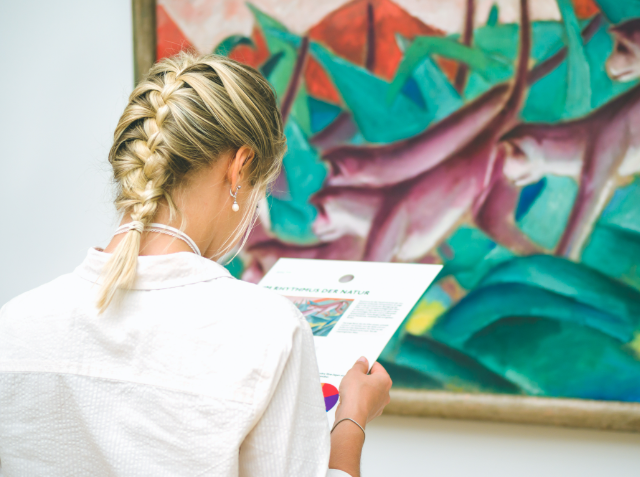- Home
- Industries
- Tourism Hospitality
- Museums Marketing Ideas
16 Creative Marketing Ideas to Attract Museum Visitors
Boost your museum’s visibility with SEO, local marketing strategies, website design, PPC advertising, blog creation, infographics, video marketing, social media engagement, email marketing and hosting unique events.
-
insights from 38,900+ hours of hospitality marketing experience
When you’re competing with other museums to get visitors in the door, you want to find ways to help your museum stand out from the crowd.
With the evolution of digital marketing, there are more opportunities than ever to boost website traffic and visits to your museum. Creative museum marketing will help you get the edge on your competition and motivate people to visit your museum.
On this page, we’ll provide you with 16 creative marketing ideas for museums. If you need help creating an innovative marketing strategy, call us today at 888-601-5359 to speak with a strategist about creating a marketing strategy unique to your museum.
1. Increase website traffic with search engine optimization (SEO)
Did you know that only 44% of businesses use search engine optimization (SEO) to reach new leads for their business? If you aren’t a part of the 44%, you’re missing an excellent opportunity to attract valuable traffic to your museum’s website.
SEO is the process of optimizing your website to boost your organic ranking in the search results and drive more traffic to your page. When you consider that 93% of online experiences begin with a search engine, it’s essential that you optimize your museum’s presence in the organic search results.
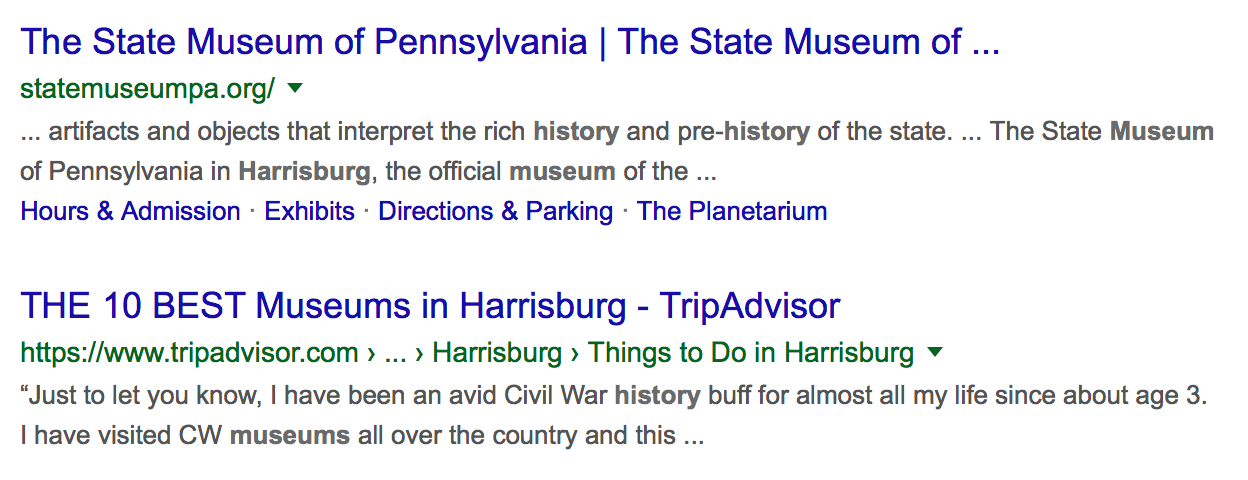
This digital marketing method has numerous moving parts. If you want to be successful with SEO, you will want to:
- Optimize for the right keywords: If you’re going to appear at the top of search results when people search keywords related to your museum, you need to optimize your site to target those terms. You’ll want to conduct keyword research to find valuable keywords and integrate them into your website. Focus on long-tail keywords, which contain three or more words, because they drive more interested traffic to your museum’s page.
- Improve page speed: Users hate to wait for slow loading pages. If your page takes too long to load, you risk losing traffic to the competition. You can use Google PageSpeed Insights to learn what you need to optimize on the backend of your site or you can invest in page speed services if you’re too busy running your museum.
- Create content: Content marketing is a valuable way to boost traffic on your site and increase your organic ranking. We’ll dive into different types of content later, but this strategy helps drive traffic and keep traffic on your website. It sends a positive signal to Google that your pages are relevant, which increases your organic ranking.
These are just a few of the core strategies to help you improve your SEO ranking. If you want to drive more traffic to learn about your museum, SEO is a great digital marketing strategy for museums that helps you boost traffic on your website.
Hear What It’s Like to Work With WebFX!

“All of my interaction with our account manager has been so positive. I worried about the amount of money I was spending and she has made it worth my while. I understand there is a team behind her as well but I have been so impressed. Her responsiveness is outstanding.”
Real Estate Rental
2. Drive more local traffic by claiming your Google Business Profile listing
Museums attract out-of-town visitors, but the biggest pool of visitors is locals. It’s vital that you invest in local marketing strategies to help you connect with these locals and get them to visit your museum. One of the essential tools for local marketing is your Google Business Profile listing.
Your Google Business Profile listing appears when leads conduct locally relevant searches. This listing is typically triggered when users perform “near me” or “near [city]” searches. When a user types in this type of search, it generates a list of three locally relevant businesses, known as the local SEO 3-pack.
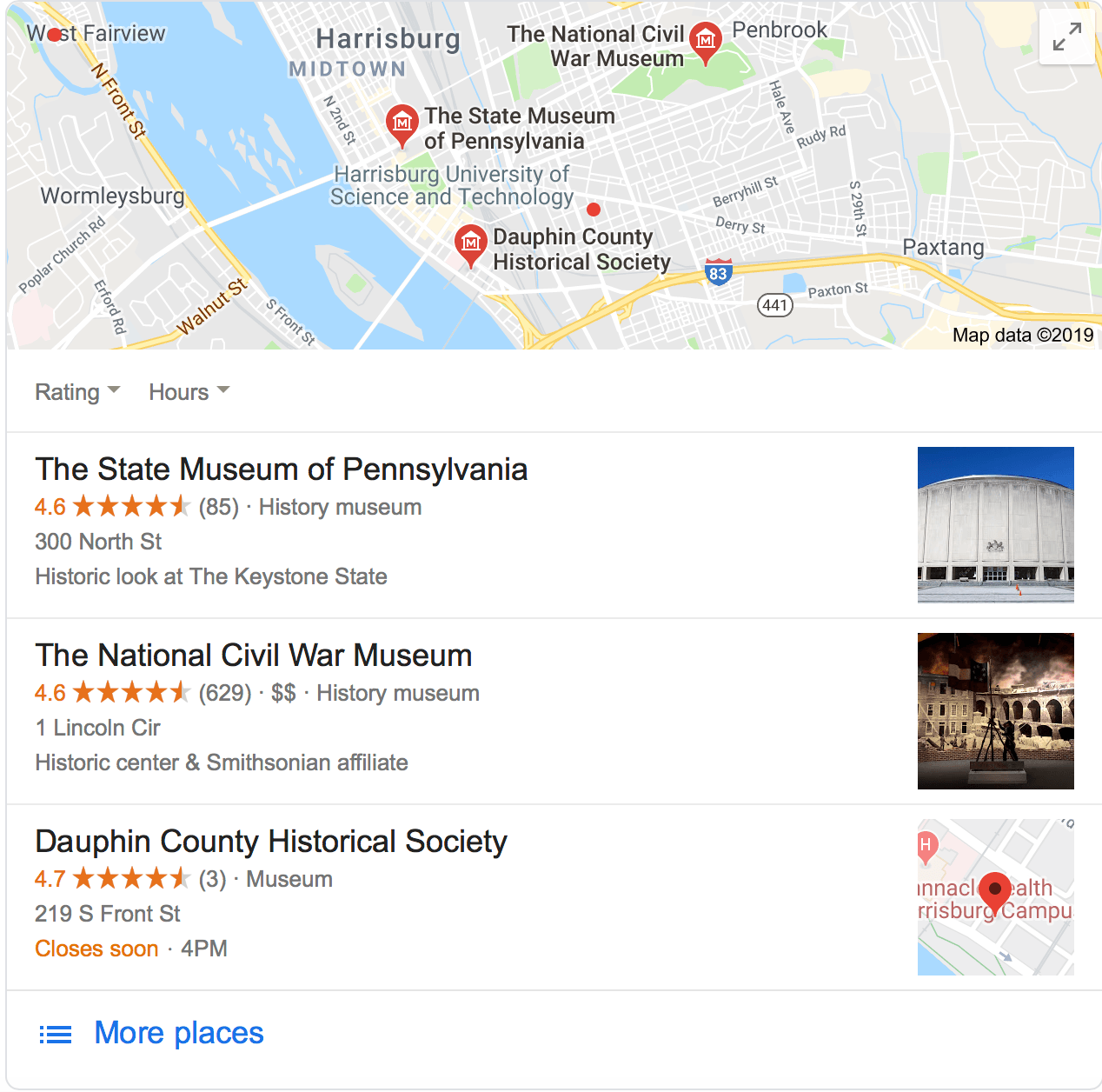
If a user clicks on one of the businesses listed in this local 3-pack, they’ll see the entirety of that business’s local listing. It’s crucial that your museum claims your listing and fills it out completely to provide your audience with the information they need. People often conduct local searches when they are out and about, looking for the right place to go.
To drive these leads to your museum, start by claiming your local listing. Once you claim it, you’ll want to fill out your profile. Add your contact information, hours of operation, and information about your museum to create an informative profile.
You can also add photos and links to valuable content to make your list fuller and more attractive. Your Google Business Profile listing provides your museum with the opportunity to give your audience the essential information fast.
If you’re looking for something to add to your museum digital marketing strategy that will boost local traffic, claiming your Google Business Profile is a good start. You’ll drive more local visitors to visit your museum.
3. Drive more traffic to your museum with geofencing marketing
Geofencing marketing is a creative marketing idea for museums that drives more traffic to your museum. With geofencing marketing, you create an invisible “fence” around your business and other museums.
When users enter the fence, they can get push notifications (if you have an app and they have it downloaded), see results for your museum if they’re conducting a search, or see your museum ads on social media.
Geofencing advertising is an excellent way for you to drive people to visit your museum when they are nearby. You can entice them to come in by showing ads or sending push notifications that make them think about visiting your museum.
This strategy is also great for driving leads from competitors’ museums to your museum. You can put your brand in front of people who are near a competitor’s museum and get them to choose your museum instead.
4. Keep leads on your museum’s website longer by investing in your website’s design
Your website is the first impression your audience gets from your museum. A whopping 94% of first impressions relate to web design. If you want to make a positive impact on leads that find your museum for the first time, you must invest in your website’s design.
When you design your website, focus on the user experience. You want people to have a positive experience when they visit your site. Positive user experience means they will spend more time on your website, getting to know your museum.
So, what are some elements of good design?
- Custom design: Your website should stand out from the competition. You want people to get on your site and remember it. A unique and customized web design will make a significant impact on your audience and help them build brand familiarity better.
- Simple navigation: You don’t want traffic to struggle to find information on your site. Good web design focuses on simple navigation that makes it easy for people to see what they need.
- Responsive design: Responsive design ensures that your website adapts to whatever devices a user is using. People will access your site from smartphones, tablets, and computers, so you want to ensure that they see the best version of your website for their device. Responsive design enables you to provide the best experience on whatever device a user uses.
- Visual elements: Users don’t want to see a site that is full of text. Visual elements, like photos and videos, provide a better experience for your audience because they break up the text and create points of interest.
These are just a few of the many elements of good design that will help you create a better website for your museum. When you look at creative museum marketing ideas, web design is one of the best. Creating a customized web design that is unique to your business will help you stand out and attract more leads to your museum.
5. Get more people into your museum through pay-per-click (PPC) advertising
If you’re looking for creative marketing ideas for museums that get people in the door, pay-per-click (PPC) advertising is the answer. PPC ads help your museum capture leads that are ready to visit a museum.
PPC ads are the most effective on Google’s search engine — and 65% of all high intent searches result in someone clicking on an ad on Google’s search engine. Google is a crucial platform for running PPC ads to reach relevant leads.
To start utilizing PPC ads, you’ll select keywords for your ad. These keywords trigger your ad to appear in search results in front of relevant leads. You want to choose keywords that your audience is using to find museums like yours.
After you select your keywords, you will bid for your ad’s placement. Your quality score and the maximum bid will determine your ad’s placement. Once you have your placement, you will launch your campaign.
When you run a PPC ad, create a landing page that is enticing and relevant. If you’re ranking for a keyword like “history museums in Harrisburg, PA,” your landing page should focus on your historical exhibits. A fantastic landing page is a crucial component to having a successful PPC ad.
By investing in PPC advertising, you will help your museum reach more valuable leads and get them to visit your museum.
6. Boost your website’s traffic by creating a blog to share valuable information
Whether you have a dinosaur, historical, or art museum, you have an abundance of knowledge about a particular subject.
There are people out there looking for that information. Your experience creates an opportunity for you to provide your audience with that valuable information and get them to check out your museum.
Blogging is an excellent opportunity for you to provide your audience with valuable information and knowledge. You can cover numerous topics regarding your museum and share that knowledge with your audience. It’s a great way to provide your audience with the knowledge and information they seek.
To start blogging, you must come up with topics. Keyword research can help you come up with core ideas for matters regarding your museum.
Once you have your keywords selected, you can get an idea on how to shape your blog post by searching your keywords through Google. When you examine your keyword results, you’ll see a “people also ask” box in the results. This box contains questions that people typically ask about your keyword.
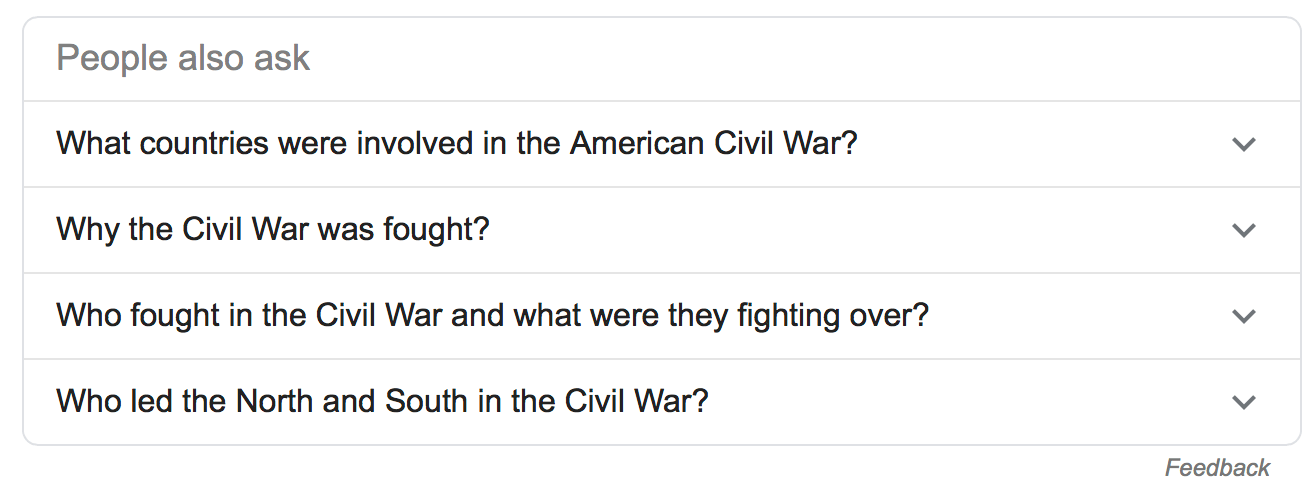
You can use this section to answer major questions in your blog posts that your audience asks. It’s a great way to provide your audience with all the information they need in one place.
Blogs are great for boosting traffic on your website and getting them to stay on your site. People take time to read blog posts, which increases your dwell time. It sends a positive signal to Google that your page is relevant to the search results, which boosts your ranking to help you drive more traffic.
If you’re looking for an effective way to drive leads to your page, blogging is a great method. You’ll attract more valuable traffic and get people to check out your museum.
7. Help explain complex or in-depth topics with infographics
Whether your museum showcases history, art, or science, you’re in fields that have complex processes or explanations. It can be challenging to explain the difference between different artistic styles, battles in a war, or how specific science experiments work. Infographics can help you clarify these various subject matters in a less complicated way.
Infographics are visual representations of information. These graphics help you explain a process with both text and images. They are incredibly useful for breaking down a process and making it less complicated.
For example, let’s say you run a history museum that has a Civil War exhibit. You’re trying to explain the different battles and how the Union or Confederate troops moved during these wars. An infographic could help you quickly layout and explain their movement and what was occurring during that period.
Infographics make it much easier to digest the information rather than writing paragraphs explain it to your audience. People are naturally visual learners, so infographics help them understand the information better.
By creating infographics, you’re creating an opportunity for your audience to understand complex topics better. It’s an excellent opportunity for you to build your brand and showcase your knowledge. Your audience will remember that you provided a helpful infographic and be more likely to visit your museum to obtain additional insight.
8. Use video marketing to give your audience an inside look at your museum
Video marketing is one creative museum marketing idea that can help you gain more leads. This content marketing tool has a powerful impact on audiences. Users spend 88% more time on pages that have videos.
People enjoy watching videos. U.S. adults spend at least five hours each day watching videos in some capacity. Users’ video watching habits creates an excellent opportunity for you to engage people and provide them with valuable information regarding your museum and exhibits.
You can create many different kinds of videos, including interviews with staff, employee spotlights, short tours of your facility (don’t tape too much of the exhibit, though!), or explanation videos that cover various relevant topics. There are dozens of different types of videos you can create for your audience!
Videos come in all different lengths and styles. You can create videos that are only 30 seconds long, or you can go more in-depth with videos that are two minutes long. The length will depend upon the topic and the purpose of the video.
Overall, video marketing is an extremely effective way for you to create enticing pieces of content that engage your audience and get them to remain on your museum’s website. It’s one of the best creative museum marketing ideas for building brand recognition and getting people interested in your museum.
9. Connect with museum-lovers through social media marketing
Social media marketing allows you to build a personal connection with people interested in your museum. You can use popular platforms like Facebook, Twitter, Instagram, Pinterest, and LinkedIn to connect with people.
Social media is a great place to share content with your audience. Each of these platforms offers the opportunity for you to highlight different aspects of your museum and share them with your audience.
You can use social media to share behind the scenes content, new photos, videos, events, links to blog posts, and more. It’s an opportunity to post content like “today in history” or “fact of the day.” You can make your posts fun and educational!
Social media offers the opportunity for you to post organic content to engage your audience and get them to think about your museum. Also, there are paid advertising options. Each social media platform offers a unique advertising program you can use to reach new leads.
These social media ads allow you to reach people who haven’t found your museum yet but would be interested in it. Many of these social media platforms have precise targeting, which makes it easier for you to reach the right people.
When you’re looking into digital marketing for museums, you’ll come across many strategies that can help your museum grow. Social media marketing is one of the best digital methods to help you stay connected with interested museum-lovers and reach new museum-goers.
10. Increase brand awareness by creating hashtags for your museum
If you’re utilizing social media as an integral part of your museum’s digital marketing strategy, there are many opportunities for you to build brand recognition with your audience. Hashtags are the easiest way to build brand recognition and engagement.
These are phrases you see behind the “#” symbol. Hashtags create the opportunity for people to see more posts relating to that hashtag. It also allows them to get involved with the conversation by adding the hashtag to their posts.
People use hashtags commonly on sites like Twitter and Instagram. These tags help you spread information about your brand and business, but you must be careful about the hashtags you choose. Both McDonald’s and DiGiorno have experienced the adverse effects of using the wrong hashtags.
If you’re careful about how you present your hashtags, they can be extremely beneficial for building brand recognition and getting people involved in the conversation.
When you create hashtags, keep them simple. You want your audience to easily remember your hashtag and be able to attach it to their posts.
Franklin Institute in Philadelphia is an excellent example of a simplistic, yet effective hashtag. For their Marvel exhibit, they created the simple hashtag “#MarvelatFI.”
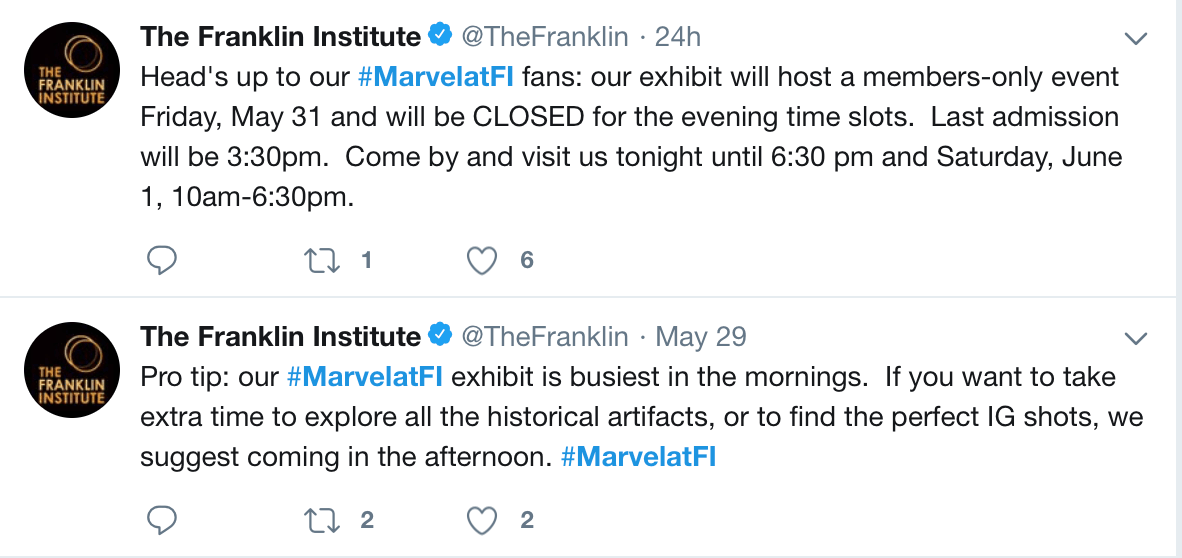
This hashtag is easy for visitors to remember and to use on their posts when they visit the exhibit. Many visitors used the hashtag when they visited the Marvel exhibit.
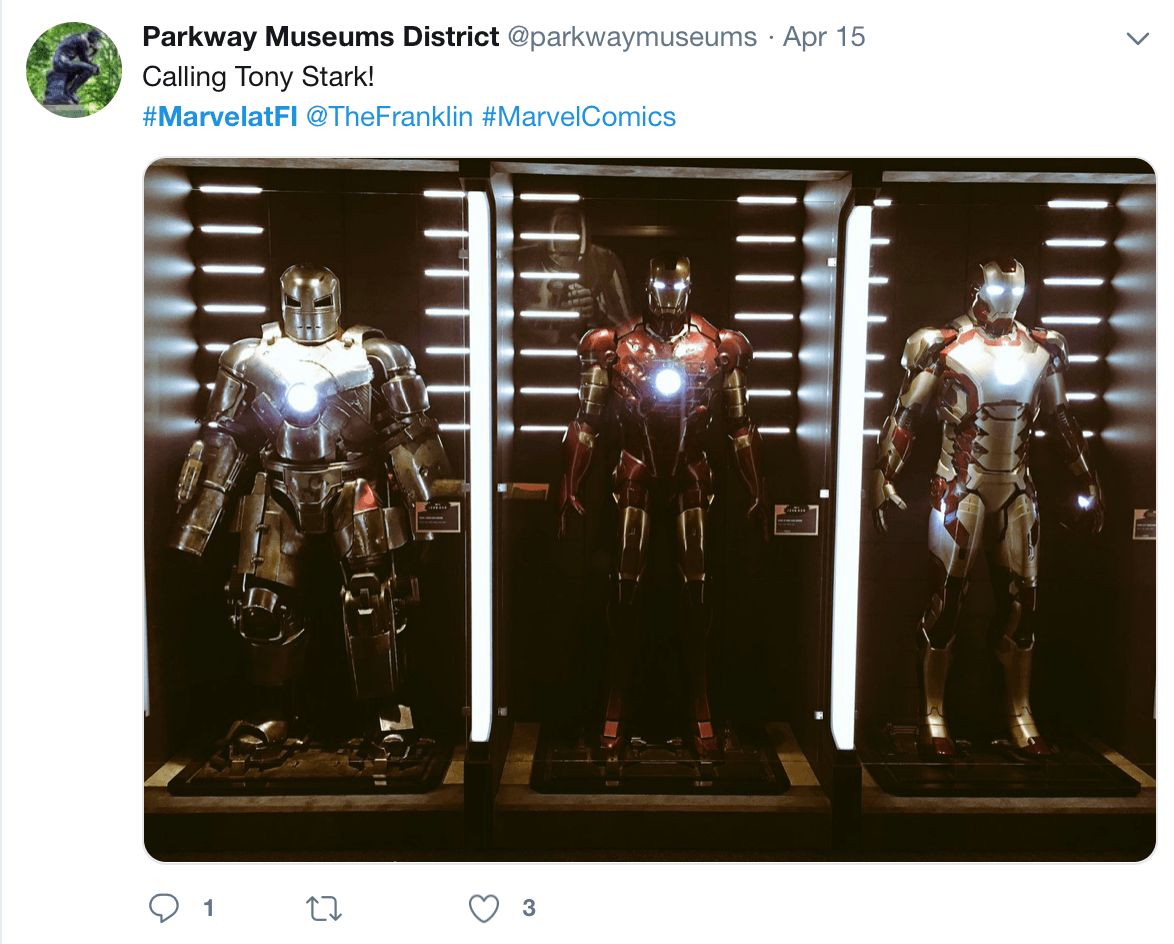
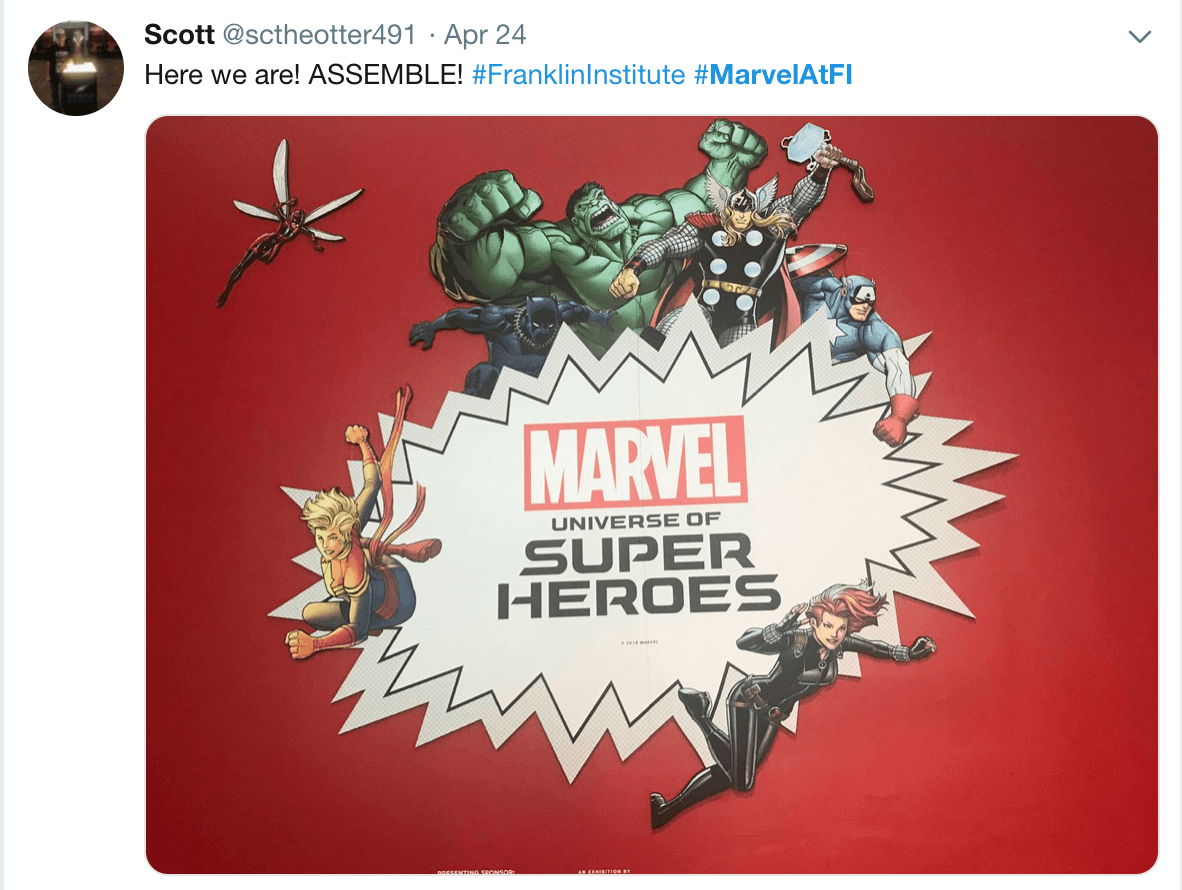
By utilizing hashtags, you can increase brand awareness and get people involved in the conversation. It’s one of the most effective creative marketing ideas for museums looking to engage more on social media.
11. Generate buzz for your museum by creating “selfie-spots” in your exhibits
With the development of better mobile devices and social media, selfie-culture has flourished. It’s not uncommon to browse through someone’s social media profile to find a selfie (or more) of themselves. Selfies are an integral part of American culture, and you can use that to your museum’s advantage.
When people visit exhibits, they often take pictures of the items on display, as well as images of themselves. So, why not take advantage of this opportunity and create “selfie-spots” for your visitors?
You can create specific parts in your exhibit that encourages your audience to take a photo. You can share your hashtags too! You can post a sign encouraging selfies and encourage visitors to include your hashtag in their posts.
Sharing your hashtags is a great way to generate buzz on social media. You’ll encourage people to post their selfies on social media, which helps you reach more people that are interested in your museum. It’s a great way to generate buzz around your exhibits!
If you want to take it a step further, you can add an incentive to encourage people to participate. You can invite them to post their selfies with your hashtag to be entered into a drawing to win free tickets, a basket full of gifts from the gift shop, or something similar!
Incentives can encourage more people to post their selfies because it’s simple, easy, and they may get something out of it. It’s a win for your museum too because you get brand exposure and reach new people!
Using “selfie-spots” can help you increase your brand exposure on social media and expand your reach. It’s one of the unique creative marketing ideas for museums that allows you to build your brand and get museum visitors more involved with your exhibits!
12. Encourage engagement with user-generated content
User-generated content is a valuable tool for marketers. Regardless of your type of business, people want your brand to be authentic and real. User-generated content helps you bring an authentic feel to your brand.
This content allows you to show your audience a first-hand experience of your museum. They can get an authentic feel for the museum and see how others experience it.
If you’re setting up selfie stations and utilizing hashtags, this is a great place to get your user-generated content. You pull posts and use them for marketing your museum on your social pages.
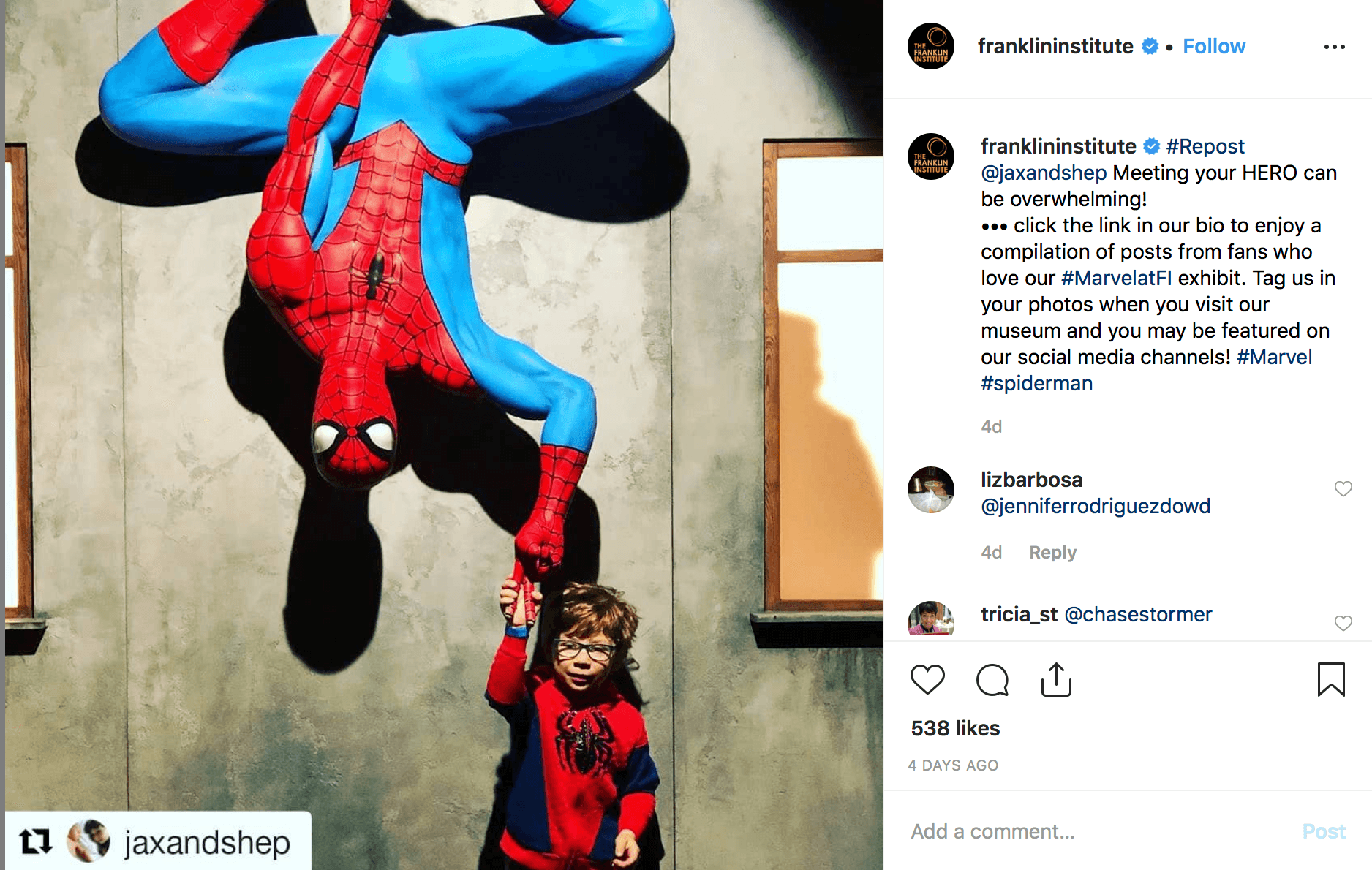
User-generated content encourages engagement with your brand, too. If people visit your museum, they may be more likely to post their photos and videos in hopes of appearing on your social pages. It’s a great way to generate more content and buzz around your museum.
By taking advantage of user-generated content, you’ll create a more authentic and relatable brand for your audience. When you invest in digital marketing for museums, be sure to include user-generated content as part of your plan.
13. Get more visitors in the door when you nurture leads with email marketing
Email marketing is a powerful method for encouraging leads to visit your museum. With email marketing, you have a direct connection to people interested in your museum and can send them tailored content to get them to visit your museum.
To start with email marketing, you must have a list of subscribers. The best way to do this is to obtain them organically through your website by creating an email sign-up form and integrating it into your site.
If people want to hear from your museum, they will volunteer to sign up for your email list. While you have the option to buy email lists, you’ll want to refrain from using them.
These lists may have a few leads that pan out, but for the most part, the people on these lists aren’t interested in your museum. Since they didn’t sign up for these emails, many of your emails will end up in the user’s spam folder. It’s best to stick to organically obtaining emails because it will drive the best results for your museum.
Once you have a list of subscribers, you can send them personalized content that gets them to visit your museum. Personalization improves the open rate of your emails by 41%. People are more likely to open your emails and engage with them when the information is pertinent to their interests.
With email marketing, you can send your audience a variety of information to get them to your museum. You can send emails about events, newsletters about what’s happening over the weekend, and more. It’s an excellent opportunity for you to personally connect with your audience and get them interested in your museum.
Email marketing is a great digital marketing strategy for museums because it helps you send personalized content to your audience. You can better appeal to people and encourage them to visit your museum.
14. Gain new leads through an email referral program
If you’re looking for one of the best creative marketing ideas for museums that helps you obtain new leads, a referral program is an answer. Referral programs are great for helping you reach leads that you aren’t reaching with other strategies.
An email referral program allows your current email subscribers to refer your museum to their friends, family, and co-workers.
Many people incentivize referral programs. When you incentivize a referral program, it means that that referrer and referee both obtain a benefit. This benefit can be money off admission, early access to a new exhibit, or other valuable incentives.
Referral programs are a cost-effective way for you to reach people who might be interested in visiting your museum.
15. Manage and monitor your digital marketing strategies better with marketing tools
Digital marketing is a big undertaking for your museum. If you’re using multiple approaches to try to attract new museum visitors, it can be challenging to keep track of everything while you’re busy running your museum. Luckily, there are many marketing tools you can use to help you run more efficient and effective campaigns.
Let’s take a look at some spectacular marketing tools you can use to help you manage your campaigns:
- Buffer: Buffer is a social media management tool that enables you to keep track of your social campaigns. You can use this tool to schedule posts, monitor engagement, and track your posts’ performance.
- MarketingCloudFX: This all-in-one software combines lead tracking, call tracking, and more. MarketingCloudFX helps you learn about your audience, personalize your content, and manage reviews.
- Canva: If you’re looking to make killer site graphics or infographics, Canva is an easy tool to use. Canva enables you to create impressive visuals for your content.
- MyEmailFX: This email software allows you to create, send, and analyze your email marketing campaign. MyEmailFX makes it easy for you to run a successful email campaign and keep all your data in one place.
- Wistia: Wistia is a video hosting platform that allows you to create, share, and manage videos for your museum.
These are just a few of the many marketing tools you can use to help you manage your creative marketing campaign for your museum. Investing in marketing tools will help you run a more efficient and effective campaign.
Don’t have the time to manage your campaign through marketing tools? WebFX can help! Call us today at 888-601-5359 to speak with one of our 500+ skilled team members that can help you create a customized marketing campaign.
16. Draw in people from your community by hosting unique events
As a museum, it can be challenging to showcase all the exciting and cool things you have in your exhibits without giving too much away. Some people may not even be aware of all you have to offer. So, how do you make people aware of your impressive exhibits?
One creative marketing idea for museums is to hold fun and unique events that get people to come out to your museum. You can host craft nights, movie nights, special summertime events, and more. You can market these events through your digital marketing strategies, too, to get more people to visit your museum.
Hosting low-cost events can be a great way to attract people to your museum. They can attend the event and become more familiar with your museum. After leaving the event, they will think about coming back to see the different exhibits you offer.
It’s also a great way to spread word-of-mouth advertising for your museum. If someone goes to an event at your museum and tells others about how they enjoyed it, it can attract more people to your museum.
By hosting unique events in your community, you can attract more people to check out your museum.
Put your creative museum marketing ideas into action today
Now that you have an abundance of creative marketing ideas for museums, you can start putting them into action. These marketing ideas will help you grow your museum and reach more people interested in visiting your exhibits. If you don’t know how to put these marketing ideas into action, WebFX can help.
We have over 28 years of experience creating digital marketing campaigns that help our clients grow their businesses. In the past five years, we’ve driven over $6 billion in sales and over 24 million leads for our clients. You can count on our team of experts to help you create a marketing campaign that drives results for your museum.
If you’re ready to start gaining more traffic and earning more valuable leads, contact us online or call us today at 888-601-5359 to speak with a strategist about getting a customized marketing strategy for your museum.
We Drive Results for Museums
- Dedicated account manager backed by 500+ digital experts
- Renowned for our communication and transparency



Table of Contents
- 1. Increase Website Traffic with Search Engine Optimization (SEO)
- 2. Drive More Local Traffic by Claiming Your Google Business Profile Listing
- 3. Drive More Traffic to Your Museum with Geofencing Marketing
- 4. Keep Leads on Your Museum’s Website Longer by Investing in Your Website’s Design
- 5. Get More People into Your Museum Through Pay-per-click (PPC) Advertising
- 6. Boost Your Website’s Traffic by Creating a Blog to Share Valuable Information
- 7. Help Explain Complex or In-depth Topics with Infographics
- 8. Use Video Marketing to Give Your Audience an Inside Look at Your Museum
- 9. Connect with Museum-lovers Through Social Media Marketing
- 10. Increase Brand Awareness by Creating Hashtags for Your Museum
- 11. Generate Buzz for Your Museum by Creating “selfie-spots” in Your Exhibits
- 12. Encourage Engagement with User-generated Content
- 13. Get More Visitors in the Door when You Nurture Leads with Email Marketing
- 14. Gain New Leads Through an Email Referral Program
- 15. Manage and Monitor Your Digital Marketing Strategies Better with Marketing Tools
- 16. Draw in People from Your Community by Hosting Unique Events
- Put Your Creative Museum Marketing Ideas into Action Today
Additional Reading
- 5 Lead Generation Strategies for Museums
- Digital Marketing for Auto Museums: 4 Strategies for Impactful Growth Online
- Museum Marketing Plan: How to Market Your Museum Effectively
- PPC for Museums: 7 Tips for Your Next Campaign
- Social Media for Museums: 8 Great Tips
- Web Design for Museums: 7 Stellar Web Design Tips for Museums
- Why SEO for Museums Matters
How We Drive Revenue for Businesses
- AI Marketing Services
- B2B Digital Marketing Agency
- Business Consulting Services
- Business Marketing Agency
- Channel Partner Marketing Agency
- Channel Partner Marketing Pricing: How Much Does Channel Partner Marketing Cost?
- Channel Partner Marketing Services
- Conversion Optimization Agency
- Conversion Rate Optimization Services
- Digital Marketing Agency for Small Business
We Drive Results for Museums
- Dedicated account manager backed by 500+ digital experts
- Renowned for our communication and transparency



Explore our hospitality case studies
Read our case studies for a more in-depth look at our results.
Solving key challenges for museums
We’re not driving enough traffic to our website
Our SEO and web design services help increase your website’s ranking in the search results when people search for your travel services or vacation spots, so you can enjoy more web traffic and sales.

We’re expanding
Set your new hotel or location package up for future success with compelling web pages and marketing messages that get your new location in front of your audience where they spend their time.

We’re not selling enough of our packages
Not selling enough of your trip packages or missing out on hotel sales? We can help you provide a seamless user experience on your website and craft personalized marketing messages that encourage your visitors to purchase your packages.

We’re not attracting new customers
Our marketing specialists help you launch strategies that expand your reach and online visibility so more people can discover your travel services online.


